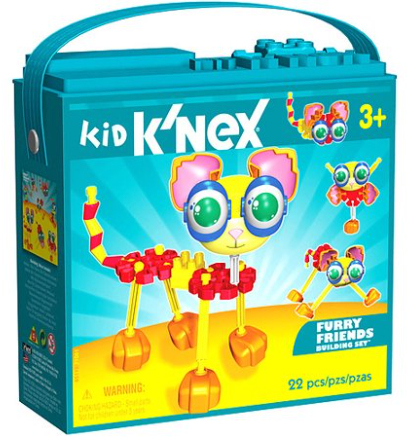 |
Build 8 models with 22 pieces. |
K'Nex is one of my favorite construction sets (LEGO is my top favorite). K'Nex pieces are unlike any other construction set that I know of and many of the sets are animal-themed, like this Furry Friends set. Some of the pieces are somewhat flexible while others are not flexible at all (like feet and eyes). This is definitely a two-handed activity and the pieces take some strength to push/pinch together.
One big reason that I prefer LEGOs over other construction sets is because sets typically include a step-by-step guide. K'Nex sets do not. You will typically get a large sheet with a number of images of finished models. The individual must be able to create a 3D model from a 2D model where parts of pieces, and even whole pieces at times, are not visible. This will take some thinking. This set includes images for eight furry friends (see below). You can only make one model at a time. To build a different model you will have to disassemble the first one since there are only 22 pieces.
 |
The 8 models in this set. |
To read more about construction toys, click here.
- Give time for free play at the beginning so that the person can examine the different shaped pieces and how they snap together.
- Ask the individual to pick up the model when possible and hold it in one hand while adding pieces with the other hand so that both hands work together while adding pieces.
- Hold the model in the non-dominant hand and pick up the correct piece in the dominant hand, setting up a natural opportunity to manipulate the piece in-hand for placement.
- Turn pieces on the table so they are not in the correct orientation. Ask the individual to pick up a piece and turn it in-hand to the correct orientation.
- Set a piece, or only a few pieces, at a time in front of the individual to cue him which piece(s) he will be placing next. It can be difficult to look at a completed model and determine where to start and/or how to proceed.
- Give the beginner one piece at a time as he needs it and point to the piece on the picture to direct where he should place it. Or gives clues such as 'let's add the head next', or 'now it's time to add the legs'.
- Cover the part of the model that you are not working on to reduce confusion or to direct the building sequence.
- Keep the unused pieces in a pile so the child will have to search for each needed piece. Turn some of the pieces upside down or half bury them under other pieces so they will look different from the picture.
- Add a piece while the individual watches if he gets stuck. Then take the piece off, turn it so that it is not in the correct orientation, and hand it to the individual to add back on.
- Advise the child to hold the model in the same orientation as the one in the picture to aid in orienting pieces.
- Have fun building your own creations. Describe them, name them, talk about the different body parts and how they will get around.
- Work on visual discrimination, visual closure, visual form constancy, figure ground, eye-hand coordination, manual dexterity, coordinated use of both hands, in-hand manipulation, finger/hand strength, motor planning, executive functioning skills, sequencing, process skills, play and leisure exploration and participation
In the box: 22 pieces, building guide


No comments:
Post a Comment
Thank you for taking the time to comment.